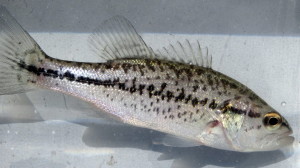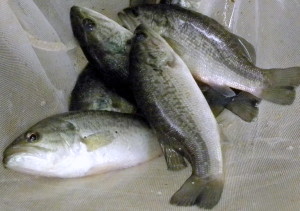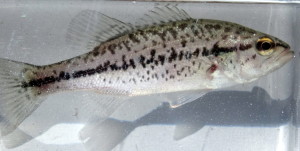Northern Largemouth Bass (Micropterus salmoides salmoides)
Florida Largemouth Bass (Micropterus salmoides floridanus)
Common Names: Largemouth Bass, Mossback, Bigmouth Bass, Bucket Mouth, Black Bass, Bayou Bass, Lineside



No matter what name you call it, the largemouth bass is the king of freshwater sportfish in Texas and the contiguous United States. It has been stocked around the world as a sport and food fish species including Japan where it has produced record catches and China where it is aquacultured for food. The largemouth bass is the most sought-after fish in Texas. According to the Texas Parks and Wildlife Department (http://www.tpwd.state.tx.us/huntwild/wild/species/lmb/): “When anglers were asked to name the fish you prefer to catch in freshwater in Texas, they chose largemouth bass three to one over striped bass, four to one over white bass, nearly five to one over channel catfish, and nearly ten to one over flathead catfish and white crappie.”
Range: The native range of the largemouth bass is from the St. Lawrence River drainage and Great Lakes, Hudson Bay, and Mississippi River drainage from southern Quebec to Minnesota and south to the Gulf of Mexico; Atlantic Slope drainages from North Carolina to Florida; Gulf Slope drainages from southern Florida into northern Mexico (Page and Burr 2011). The largemouth bass is now found in most suitable habitat across the United States, including ponds, lakes, reservoirs, and rivers from Washington state to Florida and Maine to California. The largemouth bass is one of the most widely distributed fish in the world. This is due in large part to its popularity as a sportfish. This popularity has lead to the introduction of largemouth bass populations into many areas where they are not native. Their current range includes the U.S., Canada, Central America, South America, South Africa, Europe, Guam, Japan, Lebanon, New Zealand, China, and the Philippines.
Description: The largemouth bass (Micropterus salmoides) is a member of the sunfish family (Centrarchidae) along with sunfish or breams (Lepomis spp.), crappies (Pomoxis spp.) and several other genera. Members of the genus Micropterus are known as the black basses. Largemouth bass have a large, slightly upward sloping mouth. The body is slender (especially when young) to robust, slightly flattened from side to side, producing an oval appearance in cross section. When closed, the corner of the mouth extends well past the eye, hence the common name. Largemouth bass have a divided dorsal fin (spiny front dorsal; soft-rayed rear dorsal) with the front dorsal containing nine spines and the soft-rayed dorsal containing 12 to 13 soft rays. Largemouth bass are most commonly green to light olive green above, but can appear as light or “washed out” grey as their color varies (and changes) based upon water clarity, light exposure, and temperature. Dark blotches along the side may be present to form a horizontal stripe along the middle of the fish along the sides, although this feature may be less obvious on many individuals. The belly and underside can range in color from white to light green.
Biology and Life History: There are two recognized subspecies of largemouth bass, the Florida and the Northern. These subspecies blend genetically in areas of overlap. Subspecies can be positively identified by genetic analysis, or by scale counts. The Florida largemouth has slightly smaller scales than the northern largemouth bass in relation to the size of its body. It has 69 to 73 scales along the lateral line, compared to 59 to 65 on the northern largemouth. It grows faster and reaches larger sizes in warm waters than the northern largemouth, leading to its popularity in stocking efforts across the U.S. In the southern U.S. largemouth can spawn when 1 year old if they have reached at least 10 inches in length. Males begin to select nest sites when temperatures remain higher than 60F. The male will fan out a nest about 20 inches in diameter and 6 inches deep. A substrate of sand or gravel is preferred, but silt or clay will be used if necessary. Nests are usually constructed within 7 to 8 feet of shore at depths of 1 to 4 feet (sometimes deeper if the water is very clear). Nests are usually at least 20 feet apart. Once the nest is constructed and temperatures reach 65 to 75F (April to June in most areas of the south), the male will begin to circle the nest attempting to entice a female to spawn. Then a female joins the male, they circle the nest side by side. Actual spawning occurs when the male and female tilt on their sides, with their vents in close proximity, and release eggs and sperm. Individual females usually contain 2,000 to 7,000 eggs per pound of body weight, with an average of about 4,000 eggs per female. The female usually lays a few hundred adhesive eggs at a time. She will then move off, returning later to that nest or another nest. A male’s nest will normally contain a few hundred to several thousand eggs contributed by several females. Males guard the nest and the eggs during incubation. Eggs normally hatch in about 10 days at 65 F or 5 days at 80F. Fry will remain in the nest until their yolk sacs are absorbed (1 to 2 weeks) and disperse when they are about 0.5 to 1 inch long. The male usually remains on guard until then. The nesting period is very stressful on males, and those in poor condition before spawning may die. Many eggs, and often entire nests, are lost to predation by other fishes (especially bluegill) despite the males’ attempts to protect them. After swim-up, and while they are still in schools guarded by the male, fry begin feeding on zooplankton (primarily cladocerans, rotifers and copepods). At about 1.5 to 2 inches in length largemouth begin adding larger food items, such as insect larvae and then smaller fish, to their diet. As with most fish, the growth rate of largemouth bass is highly variable and depends on food supply and environmental conditions. Largemouth can grow to more than 2 pounds their first year under ideal conditions, but in nature about 0.5 pound is normal. Females are normally larger than males. The maximum size of the Northern largemouth is about 10 pounds, while a large female Florida largemouth may reach 20 pounds. In Texas ponds, typical size at year 1 is 8″, year 2 is 12″, year 3 is 15″ year 4 is 17″ and year 5 is 18″. The current world record largemouth bass is currently a two way tie between George Perry’s 1932 fish caught in Georgia and Manabu Kurita’s 2009 fish caught in Japan. Both record fish weighed in at 22 pounds 4 ounces. The Texas state record largemouth bass weighed 18.18 pounds and was caught in 1992.
Adapted from: SRAC Publication No. 722, Species Profile – Largemouth Bass, https://extension.rwfm.tamu.edu/wp-content/uploads/sites/8/2013/09/SRAC-Publication-No.-722-Species-Profile-Largemouth-Bass.pdf
Stocking: Largemouth bass are suitable for ponds larger than 1 acre. Population management becomes difficult in ponds less than 1 acre where bass can easily become overharvested or stunted populations can develop. Largemouth bass should be stocked at a 1:10 ratio with bluegill or bluegill and redear sunfish. For new or renovated unfertilized ponds, largemouth bass should be stocked at 50 2-4″ largemouth bass to 500 2-4″ bluegill or 400 bluegill and 100 redear sunfish. For new or renovated fertilized ponds or ponds where supplemental feeding is used, largemouth bass can be stocked at 100 2-4″ largemouth bass to 1000 2-4″ bluegill or 800 bluegill and 2oo redear sunfish.
Although both largemouth bass sub-species are suitable for stocking in parts of Texas, careful consideration of your management goals should be considered before stocking either sub-species. Florida largemouth bass generally grow to a larger size, but it is more sensitive to cold temperatures. Additionally, numerous studies have demonstrated that it is more difficult to catch than the northern largemouth bass. If the goal is to catch the absolute largest bass possible and lower catch rates are acceptable, stock the Florida largemouth bass. If the management goal is to catch as many bass as possible up to about 6 pounds, stock the northern (Texas’s native) largemouth bass. Due to elevated sensitivity to cold, Florida largemouth bass should not be stocked in the northern 1/3 portion of Texas, and it is strongly discouraged in the Texas panhandle. Northern largemouth bass and Florida largemouth bass are sometimes crossbred to produce a F1, or first generation, hybrid. These hybrids produced are sometimes marketed under various trade names by fish producers. The basic concept is that the F1 may provide some of the advantages of both parent sub-species, such as increased size from the Florida sub-species combined with increased aggression or catchability from the northern sub-species. This is a phenomenon know as hybrid heterosis or hybrid vigor, in which the offspring are more fit or adaptable than either parent species, and often results in 4 or more years of excellent fishing. However, hybrid vigor generally only exists for the F1 generation. The F1s eventually will spawn with each other producing F2s, or second generation, or they will backcross with one of the parent species, either Florida or northern sub-species, if they are present. The problem is that in these successive generations, F2, F3, F4, etc., new sets of genes become dominate in the population and one or more of the good qualities introduced through hybrid vigor is lost, often leading to a population that may not have the beneficial attributes associated with either of the original parent species. Therefore, it is recommended that only a single sub-species, either the Florida or northern, be stocked into a pond. Hybrids can produce excellent fishing, but are only recommended for stocking in instances where the pond will be renovated or new genetics will be introduced every six to ten years.
Stocking pellet-trained largemouth bass is another area of consideration. In monoculture of even sized fish, largemouth bass trained to accept manufactured diets is quite effective for producing fast growing individuals. This method is also used to produce fingerlings, or juveniles, for sale as pond stockers. Often times, pellet trained largemouth bass fingerlings are sold at a premium, costing as must as two times more than un-trained largemouth bass fingerlings. There are advantages and disadvantages to purchasing pellet-trained largemouth bass for stocking. The advantages are faster growth, earlier maturation, and reduced loss to predation. Pellet-trained largemouth bass will grow faster (at first anyway) because they do not have to work as hard to obtain food and food is always available, if fed regularly. This increased growth and subsequent size means the bass will also mature earlier, sometimes spawning in the first year allowing for faster population establishment of the pond. The larger size also reduces predation, as smaller largemouth bass are more vulnerable to predation than larger individuals. The disadvantages are the fingerling cost, feed costs, reversion to piscivory (eating fish), and no generational effects. The costs of stocking 50 2-4″ un-trained, northern sub-species largemouth bass per acre typically costs between $57.50 and $82.50, while the costs for stocking 50 2-4″ pellet-trained, northern sub-species largemouth bass per acre typically runs from $92.50 to $132.50. Stocking larger ponds with pellet-trained largemouth bass can quickly become cost intensive compared to un-trained fingerlings. Most commonly available pond diets are channel catfish diets that contain between 28 and 32% protein. While these diets are fine for catfish, bluegill, redear sunfish, and baitfish, largemouth bass require higher protein diets (>40%, with 42-48% being advantageous). Therefore the diet costs are much greater for largemouth bass diets ($18 to $25 per 50 lb bag) compared to normal pond fish diets ($10 to $13 per 50 lb bag). Pellet-trained largemouth bass also have a tendency to revert to piscivory (eating fish) when baitfish such as bluegill, redear sunfish, and fathead minnows are present. The larger they become, the more likely they are to abandon eating pellets altogether, instinct simply takes over. Using typical, lower-protein pond fish diets also means that some of their protein requirement may go unfulfilled, so they must revert to eating fish to meet their protein demands. The final disadvantage is that you only get one generation out of pellet-trained largemouth bass. Largemouth bass must be “force-trained” to accept pellets in a hatchery in the absence of all other food. After these pellet trained fish spawn, their offspring do not know that they are “supposed” to be pellet trained or that they came from pellet-trained parents. They naturally and instinctively begin to prey on living food items in the pond and continue to do so for their entire life. Ergo you only get one generation, the one that you initially stocked, of pellet-trained largemouth bass. Continuing to feed pellets is still beneficial as the forage species in the pond will continue to eat the pellets and these in turn feed your largemouth bass.
